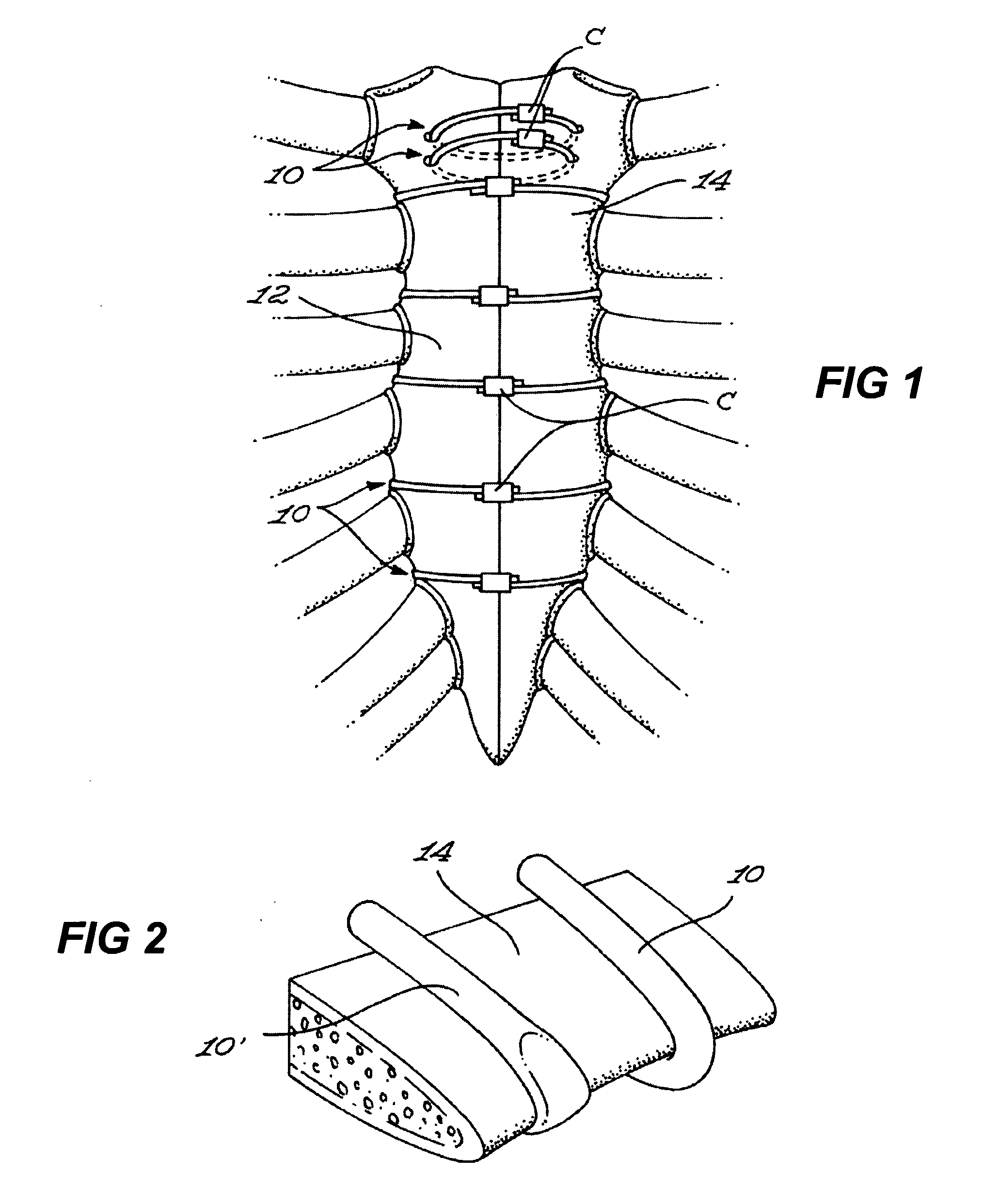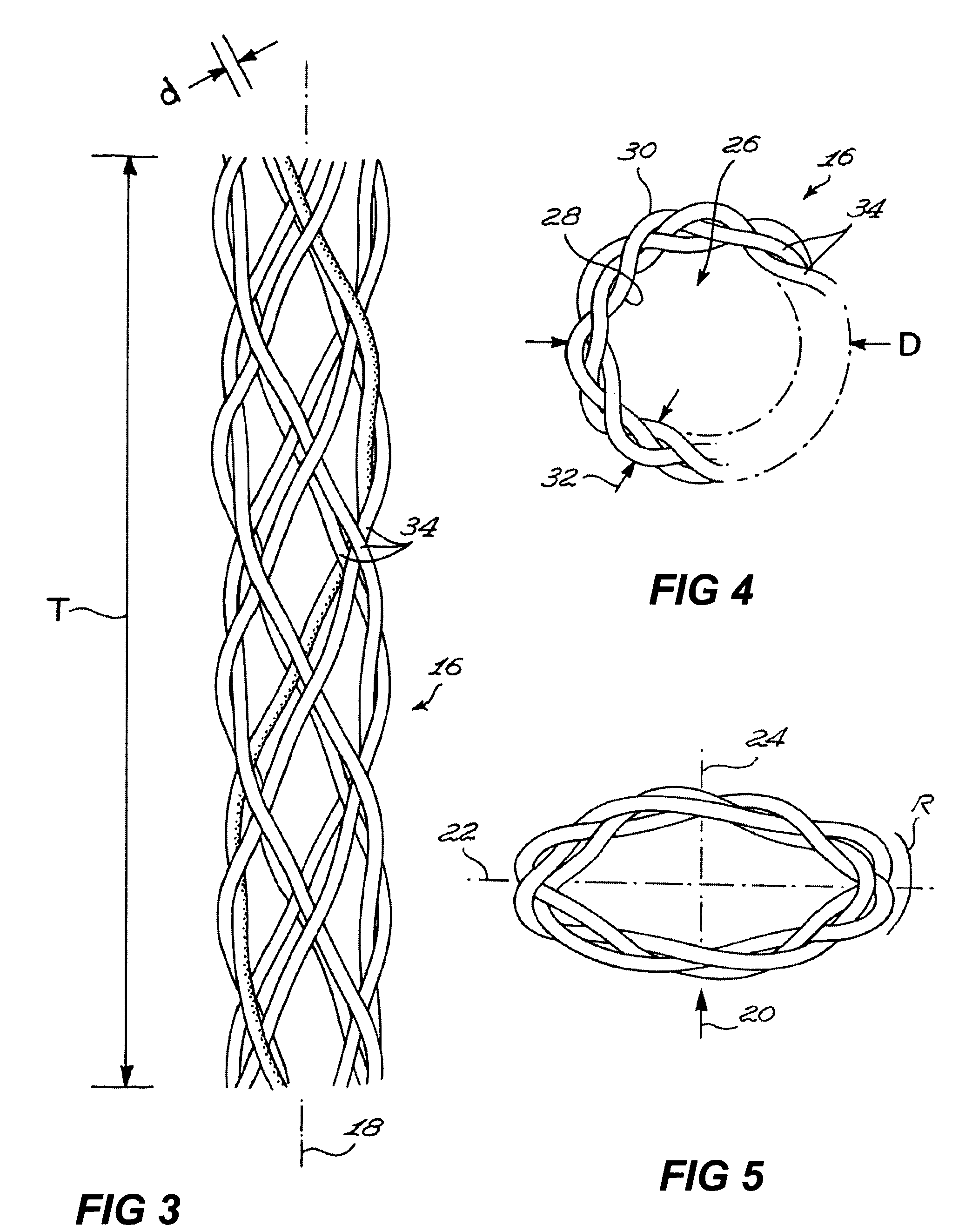Despite their widespread use, the stainless steel wires suffer from numerous drawbacks that can cause problems both to the surgeon and to the patient during the operation and to the patient after closure is completed.
For example, the relatively stiff and unyielding characteristic of a
stainless steel wire renders it unwieldy and sometimes difficult to manage on the operative field.
This substantial problem is compounded by the fact that the wire is typically
cut using a
wire cutter with relatively blunt blades, which generates a chiselled point that is typically quite sharp.
However, such clamps are also plagued with various drawbacks including cluttering of the operating field and being tedious and
time consuming to work with and around.
Furthermore, the stainless steel sternal wires can disrupt the entire image generated in a computerized axial
tomography or
magnetic resonance imaging scan of the chest for the remainder of the patient's life.
Still furthermore, tightening by twisting wires together with a pair of pliers is an inexact method.
Consequently, some suture wires break during installation.
Sternal wires occasionally also break after the
surgery.
Such breakage can be secondary to the
thinning and deformation of the steel strand by the excessive force or stresses that are sometimes applied to the loop during routine closure.
For fear of breaking a wire, a surgeon may tend to undertorque the suture, resulting in less than optimal closure pressure on the sternal knit line.
This, in turn, can lead to dehiscence problems.
A particularly major problem associated with steel wire sutures is that post-operative stress on the closure loops may cause the thin wires to cut into and through the bone of the sternum.
Indeed, since wires inherently define a relatively small contact surface,
anatomical structures may experience excessive localized pressure resulting in damage.
The coughing, deep
breathing and movement required to attain these goals imposes substantial stresses on the sternal closure.
Elderly patients or patients who have thin or osteoporotic bones are particularly susceptible to this complication.
The result is further loosening of the sternal closure which can lead to painful
instability of the two sternal halves with respiratory compromise and ultimately sternal dehiscence.
This, in turn, can increase the risks of infection and / or result in macerative damage to the
cartilage and associated
muscle tissue with a consequent increase in post-operative discomfort and in the time required for healing.
Also, if a second operation for sternal rewiring is required, it is made even more difficult by the fact that the sternal halves are often sliced into pieces by the stainless steel wires.
However, these proposed solutions tend to result in increased damage to blood vessels or other
soft tissue, and also may substantially increase the time required for closing the chest.
Also, if infection occurs necessitating removal of the sutures, it can be very difficult to remove the reinforcing wires.
However, they nevertheless suffer from various limitations which limit their utility.
For example, being substantially flat and made of relatively stiff and unyielding material, they are typically unable to fittingly contact the geometry of the sternum.
Also, their geometry is such that they cannot penetrate easily through the bone and, hence, can only be positioned peristernally between the ribs.
Consequently, they are considered unergonomical.
Typically, they are even more unwieldy and difficult to manage on the operative field than steel wires.
Still furthermore, the substantially flat shape of these bands results in relatively sharp side edges.
This, in turn, may cause internal haemorrhaging and associated problems.
The sharp side edges, if unprotected, also have considerable potential to slide into the fingers of the operating surgeon or assistants.
Furthermore, they are capable of inflicting injury to the soft tissues below the sternum during closure.
However, the components thereof are relatively large and may cause serious pain or other ailments to the patient.
A common problem to all of the hereinabove mentioned bone binding structures is that they can only be used towards fixation of the sternal halves, i.e. for immobilizing the sternal halves in close proximity to each other.
The above-mentioned structures cannot respond to this dimensional change and, consequently, cannot maintain compression across the facing boundaries of the divided sternum during the healing process.
Thus, applied pressure decreases with time.
As stated above, not only do the large initial compression forces generated with the hereinabove mentioned devices diminish in the
initial phase of
bone healing, but such large forces, in themselves, are detrimental relative to the concentrated forces experienced proximal to the wires.
Although the hereinabove mentioned structures provide some stability, they are deficient as a means to establish a known initial force and they never reconcile the need for continuous compressive force.
Furthermore, physiological activities such as coughing contribute to the degeneration not only of the sternum but also potentially of the devices themselves.
With increased deformation, there is generally a work-
hardening effect, in which the increased tangle of dislocations makes additional deformation more difficult.
Binding devices disclosed in the prior art using shape-memory alloys typically suffer from numerous drawbacks.
For example, the structure disclosed in U.S. Pat. No. 5,766,218 is relatively complex to manufacture and, hence, potentially less reliable and more expensive.
Furthermore, the use of a strap is associated with the hereinabove mentioned disadvantages inherent to its geometry.
However, again, they suffer from disadvantages inherently associated with their geometries.
 Login to View More
Login to View More  Login to View More
Login to View More 


